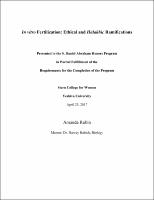Please use this identifier to cite or link to this item:
https://hdl.handle.net/20.500.12202/3980| Title: | In vitro Fertilization: Ethical and Halakhic Ramifications |
| Authors: | Rubin, Amanda |
| Keywords: | Jewish law Fertilization in vitro, Human Human reproductive technology -- Moral and ethical aspects |
| Issue Date: | 25-Apr-2015 |
| Publisher: | Stern College for Women |
| Abstract: | New developments in assisted reproductive technologies, specifically in vitro fertilization, that are meant to combat infertility issues have opened the floodgates for debate in both bioethics and Jewish law, or halakha. The most fundamental commandment in Jewish tradition is to procreate, and Judaism places great importance on a child’s parents in terms of inheritance, including Jewish identity, familial practices, and more. In the last few decades, significant progress has been made in perfecting in vitro fertilization, a process by which a fertilized embryo is implanted into a woman’s uterus. Great strides have been made in both IVF and its associated procedures that have increased its chances of success and helped to overcome both male and female infertility. In light of these advancements, many new models of either conceiving and carrying a child have left grey areas in terms of the identity of the halakhic mother or father. Several of these techniques, including Mitochondrial Replacement Therapy, gamete harvesting and freezing, and surrogacy will be identified and explored in order to discern the halakhic status of all parties involved. Numerous experts in either the scientific and halakhic fields, as well as women who have utilized these techniques, were also consulted in order to expand the discussion beyond the scope of the literature. To add an additional layer to this work, an IVF laboratory was visited and its clinicians consulted in order to learn more about the science and medicine of fertility. The goal was to identify who the halakhic parent may be in the specific cases mentioned, and also highlight the need to establish a halakhic model that is versatile enough to apply to all possible scenarios. |
| Description: | The file is restricted for YU community access only. |
| URI: | https://hdl.handle.net/20.500.12202/3980 https://ezproxy.yu.edu/login?url=https://repository.yu.edu/handle/20.500.12202/3980 |
| Appears in Collections: | S. Daniel Abraham Honors Student Theses |
Files in This Item:
| File | Description | Size | Format | |
|---|---|---|---|---|
| Amanda-Rubin.pdf Restricted Access | 404.7 kB | Adobe PDF |  View/Open |
This item is licensed under a Creative Commons License

